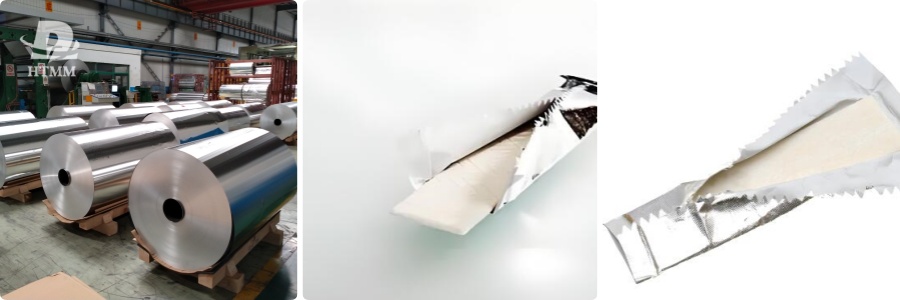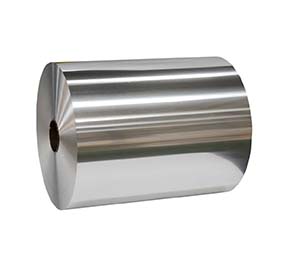Chocolate Packaging
Aluminum foil is extremely well-suited for chocolate packaging due to its barrier properties. It provides an effective moisture and oxygen barrier, helping to preserve freshness and prevent staling. The aluminum prevents moisture from escaping or entering the chocolate, which could cause blooming, whitening or deteriorate the texture over time.

Some key uses of Aluminum foil for chocolate include:
Chocolate bar wrappers - Thin gauge foil is commonly used as the primary packaging layer for individually wrapped chocolate bars. It offers protection and maintains quality until the chocolate is consumed.
Box lining and interior films - Heavier gauges of foil are often used to line cardboard boxes that contain multiple chocolate bars or assorted items. This helps block moisture, oxygen and light and extends shelf life. Some boxes even have a thin interior polyethylene film laminated to the foil for enhanced printability.
General purpose overwraps - Foil is applied as an overwrap on various bulk packages of chocolates like pralines, truffles or other assorted chocolates. It seals in freshness during transport and storage.
Decorative and premium foils - Higher quality foils are produced with various decorative effects like colors, patterns or embossing for premium brands looking to elevate their packaging appeal. Some foils are also laminated to paperboard for a multi-material design.
Strip packs - Thin foils can be die-cut and converted into 'blister packs' or 'clamshells' to individually encapsulate chocolates or snacks for single-serve convenience.
Chewing Gum Packaging
Aluminum foil plays an equally important role in gum packaging where moisture and gas barriers are key. Aluminum foil for chewing gum. Some 75-80% of chewing gum is packaged using foil-based materials according to industry sources.

Primary foil wrappers - Ultra thin and strong foil is commonly used to wrap stick gum and center-filled gum individually. The foil maintains freshness and texture until consumption.
Bulk and convenience packs - Heavier foil is employed as the primary layer in multi-pack boxes, tins, and other bulk formats for gum. It protects quality during transport and storage.
Lidding films - Thin laminated foils are adhered to plastic tubs and jars as an effective lidding film to seal in gum packs until opening. Some incorporate a laser-scored tear line for easy removal.
Export packaging - Heavier gauge foil is preferred for gum exported to regions with high humidity, to provide a robust moisture barrier during long-distance shipping.
Graphic capabilities - Advanced printing and coating technologies allow vivid graphics and eye-catching designs to be reproduced directly on foil-based gum wrappers.
Other Confectionery Uses

Beyond chocolate and gum, aluminum foil has many applications across other sectors of the global confectionery market estimated at over $200 billion:
Aluminum foil for candy - Colorful foils are consistently used to wrap numerous hard candies like lollipops, mints, individually wrapped items.
Baked goods packaging - Foil trays, overwraps and bags protect the freshness of pie slices, pastries, cookies and more. Some feature a gas-flushing technology to displace air.
Novelty items - Die-cut foils create attractive single-serve blister packs for candy necklaces, novelty candies and other seasonal items.
Food service packaging - Foil bags, tins and containers provide portion control and shelf stability forConfectioners supplying restaurants and fast food chains.
These are just some of the primary roles that aluminum foil serves across the global confectionery sector. As the no.1 form of active packaging material, foil ensures product quality, consistency and hygienic handling throughout the supply chain.
Key Properties for Confectionery Use
There are several key physical properties that make aluminum foil such an optimal material for confectionery applications:
Formability - 1235 O 7 micron aluminum foil is easy to die-cut, bend, emboss, wrinkle, or mould into virtually any shape. This affords limitless possibilities for unique package designs.
Shelf impact - The glossy shimmer and premium look of foil-based packaging stands out vibrantly on crowded store shelves compared to dull plastic or paper shelves.
Interactive properties - Innovations allow foil to be made microwave-safe, easy-open, tamper-evident or undergo plasma treatments for Special effects.
Raw Material Sourcing and Quality Considerations
As one of the world's major aluminum foil producers, it is important for HTMM to carefully source prime quality raw materials to satisfy our customers' stringent packaging requirements within confectionery and other industries.
All aluminum coil arrives through stringent quality inspection to verify it meets our specifications for purity (99% min Al by weight), thickness tolerances, surface quality etc. Specialty alloys may also be employed depending on end-use demands like food grade or foil laminate needs.
On the foil converting side, selection of washing chemicals, lubricants and release liners are vetted to ensure compliance with food safety certifications. State-of-the-art equipment including multilayer calendaring lines and precision slitting are deployed to optimally process different foil gauges requested by customers.
Consistent Quality through Process Control
Given the zero-defect quality expectations of confectionery wrappers and packaging, HTMM prioritizes strict process control and SPC programs. Continuous monitoring with quality charts helps optimize variables like foil flatness, wrinkling, breakage rates etc.
Critical factors such as substrate tension, calendar roll pressures, drying oven temps are PID-controlled. Changeovers between product grades are quickly validated. In-line vision inspection and laser micrometers further screen for defects.
Real-time data collection allows us to pinpoint potential issues and take preventative action before quality can be impacted. Advanced statistical tools reveal correlations between input parameters and KPIs for continual improvement. Systematic audits are conducted to monitor control plans as well.





